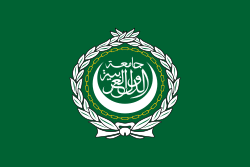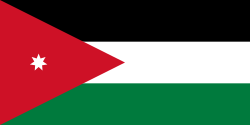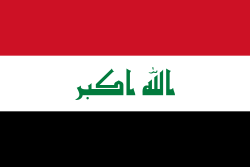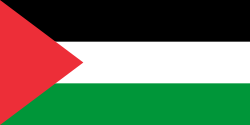Arab-israeliska konflikten
| Arab-israeliska-konflikten | |||||
|---|---|---|---|---|---|
| |||||
| Stridande | |||||
Machalfrivilliga Falangistpartiet (1978–1982) Fria libanesiska staten (1978–1984) Stöd från: |
Stöd från: | ||||
| Befälhavare och ledare | |||||
Moshe Dayan (1948–1979) Saad Haddad (1978–1984) Antoine Lahad (1984–2000) | |||||
| Förluster | |||||
| ≈ 22 570 militära dödsfall[2] ≈ 1 723 civila dödsfall[3] ≈ 1 050 SLA-miliser[4] | 91 105 arabiska dödsfall (totalt)[5] | ||||
| 74 000 militära dödsfall 18 000 civila dödsfall (1945–1995)[6] | |||||
| |||||
Arab-israeliska-konflikten är en serie av konflikter och dispyter i Mellanöstern mellan ett flertal av de så kallade arabiska staterna i Arabförbundet och Israel, vilken har pågått sedan 1948. I centrum för konflikten står staten Israels bildande (1948) och den dithörande Israel–Palestina-konflikten. Konflikten har orsakat flera krig i området, och påverkar mellanstatliga relationer i hela världen.
Även staten Iran räknas som part i Mellanösternkonflikten vid sidan om arabstaterna efter Irans islamiska revolution 1979[7] bland annat genom att understödja Hamas i Gaza, Hizbollah i Libanon och huthier i Jemen.
Till de krig som ses som delar av Mellanösternkonflikten hör 1948 års arabisk-israeliska krig, Israel–Libanon-konflikten och dithörande krig, Sexdagarskriget och Jom kippur-kriget. Arabvärlden har även utfärdat olika bojkotter mot Israel, och släpper inte in människor med israeliska pass eller (i många fall) israeliska passtämplar i sina länder. Mellanösternkonflikten är inte begränsad till staten Israels existens och den palestinska flyktingssituationen utan omfattar även de områden som Israel ockuperar. Under Kalla kriget kännetecknades konflikten till en del av den ideologiskt betingade motsättningen mellan USA och Sovjetunionen.[förklaring behövs][källa behövs]
Strategic Foresight Group(en), en tankesmedja grundad 2002 i Indien, har för flera konflikter beräknat en alternativkostnad ("opportunity cost") där man för en tidsperiod jämför verklig utveckling av BNP med en uppskattning av möjlig BNP-utveckling vid fredliga förhållanden.
Med vissa antaganden anger man den totala alternativkostnaden för perioden 1991 till 2010 för länderna i Mellanöstern till $ 13 500 miljarder, varav Israels andel är drygt $ 1 000 miljarder, Irak cirka $ 2 300 miljarder och Saudiarabien till cirka $ 4 500 miljarder, allt angivet i dollarkurs för 2006.[8]
Den mänskliga förlusten på grund av konflikten beräknas till 92 000 liv (74 000 militärer och 18 000 civila under åren 1945–1995)[9]
Se även
Referenser
- ^ Pollack, Kenneth, M., Arabs at War: Military Effectiveness, University of Nebraska Press, (2002), pp. 93–94, 96.
- ^ Memorial Day / 24,293 fallen soldiers, terror victims since Israel was born. Haaretz. Retrieved on 28 July 2014.
- ^ Memorial Day / 24,293 fallen soldiers, terror victims since Israel was born. Haaretz Retrieved on 28 July 2014.
- ^ Hamzeh, Ahmad Nizar (1 January 2004). ”In The Path Of Hizbullah”. In The Path Of Hizbullah. Syracuse University Press. https://books.google.com/books?id=HNyv0N8cVE0C&printsec=frontcover&dq=in%20the%20path%20of%20hezbollah&hl=no&sa=X&ei=NS2cVfnHHYG2-QHdjbWQAw&ved=0CB0Q6AEwAA#v=onepage&q=in%20the%20path%20of%20hezbollah&f=false.
- ^ Total Casualties, Arab-Israeli Conflict. Jewish Virtual Library.
- ^ Buzan, Barry (2003). Regions and powers. Cambridge University Press. ISBN 978-0-521-89111-0. https://books.google.com/?id=N3LfkrrNM4QC&pg=PA215&dq=arab-israeli+fatalities. Läst 21 april 2009
- ^ Nikou, Semira N.. ”Timeline of Iran's Foreign Relations”. United States Institute of Peace. http://iranprimer.usip.org/resource/timeline-irans-foreign-relations. Läst 7 oktober 2017.
- ^ ”Cost of conflict in the Middle East, Strategic Foresight Group”. Arkiverad från originalet den 1 februari 2009. https://web.archive.org/web/20090201053723/http://www.strategicforesight.com/Cost%20of%20Conflict%20-%206%20pager.pdf. Läst 12 mars 2018.
- ^ Buzan, Barry (2003). Regions of powers. sid. 215. Läst 12 mars 2018
|
Media som används på denna webbplats
Flag of Israel. Shows a Magen David (“Shield of David”) between two stripes. The Shield of David is a traditional Jewish symbol. The stripes symbolize a Jewish prayer shawl (tallit).
A green flag with a white inscription above a crescent moon with horns upwards, all within a circle of chain and all around a white wreath with a ribbon at the base. Proportion 2:3 reported in Pavillons nationaux et marques distinctives. FOTW
- in the center an Arabic script for "League of Arab States" (Arabic: جامعة الدول العربية)
- Proportion 2:3 as reported.
- Green similar to 60 Years anniversary flag shown on the official site.
Flag of Iran. The tricolor flag was introduced in 1906, but after the Islamic Revolution of 1979 the Arabic words 'Allahu akbar' ('God is great'), written in the Kufic script of the Qur'an and repeated 22 times, were added to the red and green strips where they border the white central strip and in the middle is the emblem of Iran (which is a stylized Persian alphabet of the Arabic word Allah ("God")).
The official ISIRI standard (translation at FotW) gives two slightly different methods of construction for the flag: a compass-and-straightedge construction used for File:Flag of Iran (official).svg, and a "simplified" construction sheet with rational numbers used for this file.
Flag of Hejaz from 1917 to 1920 (1335-1338 A.H.), commonly known as the "Arab revolt flag".
Författare/Upphovsman: Vallecyofdawn, modified by Zscout370, Licens: CC BY-SA 3.0
Marking with a dagger stabbing a Magen David. Historical status as a flag is unknown, possibly dubious, but as a historical emblem or insignia, see images (smaller, larger) linked from [1]
Logo of the Lebanese Phalanges Party.
Flag of Syria. Originally flag of the Syria Revolution (from 2011), de facto flag of Syria beginning December 2024, official beginning March 2025.
The en:Shahada in white calligraphy on a green background. Reported as the "Flag of Hamas" in flaggenlexikon.de . Uploaded 2007.
The Flags of the World website discussed the validity of this flag after it was displayed as an alleged "flag of Hamas" by Wikipedia in 2007.
According to a 2006 comment:
- "The military branch of Hamas has a different flag, green with Shahada on it. Maybe that's why there is a confusion about the Hamas flag. One is white with Hamas emblem on it, and the military branch's flag is green with a shahada? At least, the green flag is there at all protests and demonstrations." (Valentin Poposki, 03 Mar 2006)
Use of this flag was reported as early as 2001:
- "Hamas' flag is green (Muslim colour) with Arabic words in white. I saw this flag several times at Hamas demonstrations and at generic anti-Israel events in Palestine. Hamas emblem is here." (Santiago Tazón, 20 Dec 2001)
While this flag has apparently been spotted in Hamas demonstrations since at least 2001, it cannot be identified as "the flag of Hamas". It has rather been carried by Hamas supporters as symbolizing Islam or Islamism, not as an emblem of Hamas as an organization.
- "It would be wrong to name the flag as the Hamas flag. Such flags, with the Sha'ada in white on green or black, are used by other Islamic groups and are not unique to Hamas. Therefore it is not the 'Hamas flag' but rather a flag used also by the Hamas." (Dov Gutterman, 29 Mar 2003)
















